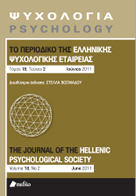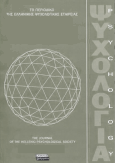Το φανταστικό ακροατήριο και ο προσωπικός μύθος των εφήβων σε σχέση με τη διαδικασία αποχωρισμού-εξατομίκευσης

Περίληψη
Στόχος αυτής της έρευνας ήταν ο εμπειρικός έλεγχος του εναλλακτικού θεωρητικού μοντέλου για την ερμηνεία του εφηβικού εγωκεντρισμού, το οποίο έχει προταθεί από τον Lapsley (1993), σε αντιδιαστολή με το κλασικό γνωστικό μοντέλο που εισήγαγε ο Elkind (1967). Σύμφωνα με το εναλλακτικό μοντέλο, οι δύο εκδηλώσεις του εφηβικού εγωκεντρισμού –το φανταστικό ακροατήριο και ο προσωπικός μύθος– είναι υγιείς προσαρμοστικοί μηχανισμοί που χρησιμοποιεί ο έφηβος για να αντιμετωπίσει την αγχογόνο αναπτυξιακή απαίτηση του ψυχολογικού αποχωρισμού από τους γονείς και της εξατομίκευσής του. Συμμετείχαν 297 έφηβοι 11-18 ετών περίπου. Συμπλήρωσαν την Κλίμακα Φανταστικού Ακροατηρίου (Elkind & Bowen, 1979), τη Νέα Κλίμακα Φα-
νταστικού Ακροατηρίου (Lapsley, Fitzgerald, Rice, & Jackson, 1989), την Κλίμακα Προσωπικού Μύθου (Elkind, personal communication, August 10, 1993), τη Νέα Κλίμακα Προσωπικού Μύθου (Lapsley et al., 1989) και την Κλίμακα Αποχωρισμού-Εξατομίκευσης των Εφήβων (Levine, Green, & Millon, 1986. Levine & Saintonge, 1993). Το εναλλακτικό μοντέλο του εγωκεντρισμού επαληθεύτηκε σε γενικές γραμμές. Οι διαστάσεις του αποχωρισμού είχαν θετική συνάφεια με το φανταστικό ακροατήριο, ενώ οι διαστάσεις της εξατομίκευσης είχαν θετική συνάφεια με τον προσωπικό μύθο. Επίσης, διαπιστώθηκαν και κάποιες σχέσεις λιγότερο ισχυρές μεταξύ του αποχωρισμού και του προσωπικού μύθου, καθώς και μεταξύ της εξατομίκευσης και του φανταστικού ακροατηρίου. Προέκυψαν στοιχεία για το διαφορετικό ρόλο που παίζουν οι επιμέρους διαστάσεις
του εγωκεντρισμού στη διαδικασία αποχωρισμού-εξατομίκευσης. Βρέθηκαν, ακόμη, συστηματικές διαφορές ηλικίας και φύλου. Τα ευρήματα συζητούνται στα πλαίσια της διεθνούς βιβλιογραφίας για τον εφηβικό εγωκεντρισμό και τις σχέσεις γονέων-εφήβων.
Λεπτομέρειες άρθρου
- Πώς να δημιουργήσετε Αναφορές
-
P. Galanaki, E., & Christopoulos, A. (2020). Το φανταστικό ακροατήριο και ο προσωπικός μύθος των εφήβων σε σχέση με τη διαδικασία αποχωρισμού-εξατομίκευσης. Ψυχολογία: το περιοδικό της Ελληνικής Ψυχολογικής Εταιρείας, 18(1), 85–103. https://doi.org/10.12681/psy_hps.23710
- Τεύχος
- Τόμ. 18 Αρ. 1 (2011)
- Ενότητα
- ΕΜΠΕΙΡΙΚΕΣ ΕΡΓΑΣΙΕΣ

Αυτή η εργασία είναι αδειοδοτημένη υπό το Creative Commons Attribution-ShareAlike 4.0 International License.
Το περιοδικό ΨΥΧΟΛΟΓΙΑ έχει υιοθετήσει μία πολιτική Platinum open-access. Τα έξοδα υποβολής, επεξεργασίας ή δημοσίευσης των εργασιών καλύπτονται από την Ελληνική Ψυχολογική Εταιρεία. Τα πνευματικά δικαιώματα των δημοσιευμένων εργασιών προστατεύονται από την άδεια 'Creative Commons Attribution-ShareAlike 4.0 International'. Οι Συγγραφείς διατηρούν τα Πνευματικά Δικαιώματα και χορηγούν στο περιοδικό το δικαίωμα της πρώτης δημοσίευσης. Η άδεια αυτή επιτρέπει σε τρίτους, να χρησιμοποιούν την εργασία σε οποιαδήποτε μορφή, με την προϋπόθεση της διατήρησης των διατυπώσεων που προβλέπονται στην άδεια σχετικά με την αναφορά στον αρχικό δημιουργό και την αρχική δημοσίευση στο περιοδικό ΨΥΧΟΛΟΓΙΑ. Επιπλέον, κάθε διανομή της εργασίας οφείλει να γίνεται με τους ίδιους όρους διανομής, δηλαδή με την ίδια άδεια Creative Commons.



